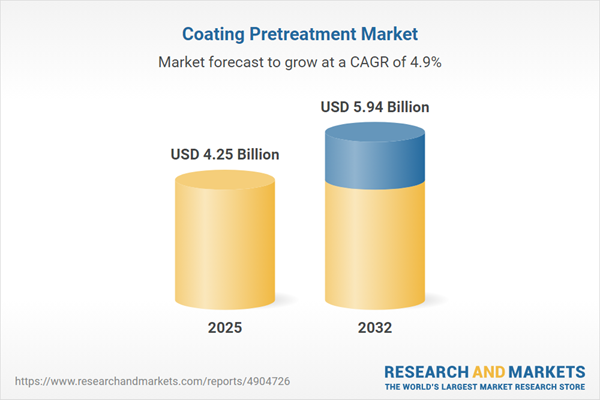Speak directly to the analyst to clarify any post sales queries you may have.
The global coating pretreatment market is evolving as industries demand higher durability, improved process efficiency, and stronger regulatory alignment. Senior decision-makers must evaluate the dynamic interplay of technology advancements, sustainability imperatives, and emerging compliance requirements shaping the future of this essential segment.
Market Snapshot: Coating Pretreatment Market Size and Trends
The coating pretreatment market grew from USD 4.05 billion in 2024 to USD 4.25 billion in 2025. It is anticipated to maintain an upward trajectory with a CAGR of 4.91%, reaching USD 5.94 billion by 2032. This expansion is driven by rising adoption across automotive, construction, electronics, and industrial sectors, responding to heightened requirements for corrosion resistance, substrate compatibility, and cost-effective process solutions.
Scope & Segmentation
This in-depth research delivers segment-specific intelligence and actionable insights, equipping executives to refine operations, prioritize investments, and lead innovation in a shifting landscape.
- Pretreatment Technology: Chromate conversion (hexavalent, trivalent); non-chromate conversion (phosphorosilicate treatment, silanization); passivation; phosphating (iron, manganese, zinc phosphate); zirconium treatment.
- Substrate Material: Aluminum and alloys (cast, wrought), galvanized steel, iron, carbon steel, stainless steel.
- End Use Industry: Appliances, automotive (aftermarket, OEM), construction, electronics, general industrial (equipment, machinery).
- Regional Coverage: Americas (North America: United States, Canada, Mexico; Latin America: Brazil, Argentina, Chile, Colombia, Peru), Europe, Middle East & Africa (including United Kingdom, Germany, France, Russia, Italy, Spain, Netherlands, Sweden, Poland, Switzerland, United Arab Emirates, Saudi Arabia, Qatar, Turkey, Israel, South Africa, Nigeria, Egypt, Kenya), Asia-Pacific (China, India, Japan, Australia, South Korea, Indonesia, Thailand, Malaysia, Singapore, Taiwan).
- Key Companies Analyzed: Henkel AG & Co. KGaA, PPG Industries, Inc., Akzo Nobel N.V., BASF SE, Axalta Coating Systems Ltd., 3M Company, MKS Instruments, Inc., Element Solutions Inc., Quaker Houghton Corporation, DuPont de Nemours, Inc.
Key Takeaways: Strategic Insights for Senior Decision Makers
- Digital solutions and automation are transforming operational performance, enabling real-time monitoring and predictive quality control across pretreatment lines.
- Sustainability priorities are prompting rapid adoption of eco-friendly chemistries and closed-loop wastewater management, catering to growing regulatory and customer expectations.
- Advanced conversion coatings, including non-chromate innovations and bio-based technologies, are reshaping value propositions and driving differentiation among providers.
- Distinct substrate requirements highlight the need for customized formulations and process parameters, especially for aluminum, galvanized steel, and high-performance electronics assemblies.
- Collaborative partnerships between suppliers and OEMs promote tailored solutions and streamline supply chain integration, reinforcing competitiveness in key end-use markets.
Tariff Impact: U.S. Regulatory Shifts and Supply Chain Strategies
Impending tariff adjustments in the United States are expected to impact material costs for key pretreatment inputs, such as specialty acids and silane coupling agents. This will require suppliers to reassess sourcing, consider near-shoring, and diversify networks to limit exposure to increased procurement expenses. Companies prepared to adapt their pricing structures, invest in efficiency, and prioritize strategic supplier partnerships will be better positioned to manage volatility and maintain market share.
Methodology & Data Sources
Comprehensive insights derive from both qualitative and quantitative analysis. Primary research included interviews with industry executives, technical specialists, and end users. Secondary research incorporated scientific literature, regulatory reports, company documents, and trade association data. Analytical validation and peer review supported data verification and trend analysis, ensuring findings reflect market realities.
Why This Report Matters: Value for Decision Makers
- Identify actionable growth strategies and risk mitigation approaches through deep segmental analysis and executive-focused recommendations.
- Support investment decisions with clear visibility into innovation trends, regulatory shifts, and regional differences shaping supply and demand.
Conclusion
As industry standards evolve and market drivers shift, informed strategic action is crucial for sustained growth in coating pretreatment. Use this analysis to anticipate changes, enhance operational agility, and advance your competitive position in a complex global market.
Additional Product Information:
- Purchase of this report includes 1 year online access with quarterly updates.
- This report can be updated on request. Please contact our Customer Experience team using the Ask a Question widget on our website.
Table of Contents
3. Executive Summary
4. Market Overview
7. Cumulative Impact of Artificial Intelligence 2025
Companies Mentioned
The companies profiled in this Coating Pretreatment market report include:- Henkel AG & Co. KGaA
- PPG Industries, Inc.
- Akzo Nobel N.V.
- BASF SE
- Axalta Coating Systems Ltd.
- 3M Company
- MKS Instruments, Inc.
- Element Solutions Inc.
- Quaker Houghton Corporation
- DuPont de Nemours, Inc.
Table Information
| Report Attribute | Details |
|---|---|
| No. of Pages | 186 |
| Published | October 2025 |
| Forecast Period | 2025 - 2032 |
| Estimated Market Value ( USD | $ 4.25 Billion |
| Forecasted Market Value ( USD | $ 5.94 Billion |
| Compound Annual Growth Rate | 4.9% |
| Regions Covered | Global |
| No. of Companies Mentioned | 11 |









